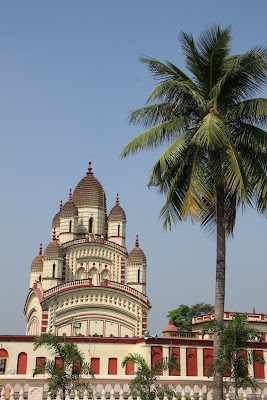The end of September through October was an intensive and busy period work-wise (though, does it ever seem to slow down?), and I spent a bulk of my time yet again in India, initially in Gaya, Bihar, our project site. Our VPs for Microfinance and Technology had wanted to see how down market Grameen Foundation was going in terms of the clients we serve, and a trip was arranged for them to visit the typical microfinance clients of our partner, followed by a visit to a village to meet the women of self-help groups who might be considered middle field- not quite credit worthy and income stable for mainstream microfinance but still not considered poorest of the poor. The trip concluded with a visit to our target households, who are considered the ultra poor. The contrast between this group and the clients they had met earlier in the visit was quite stark. Household income streams are extremely volatile and irregular, average income per household member per day often amounts to a mere 18 Indian rupees (U$D 0.38), and living conditions are extremely crude.
The design of our financial and non-financial products and services to holistically address the causes of poverty for this target group is still underway. It has really been one of the most challenging assignments I’ve had to date, primarily because of the novelty around this thinking within the microfinance industry at large, but also because of the impact that these interventions can have on the lives of so many people. Our planning and strategizing continued in Patna and then unexpectedly carried on in Calcutta or Kolkata, the culture capital of India and where our partner institution’s regional office is based. The timing could not have been more opportune, I thought, as I eagerly made my way there via air. It was Navarathri, and the middle three days of the nine day festival are best celebrated in Bengal. To witness and experience Durga Puja, a celebration of the triumph over evil by Durga or Kali, the supreme form of the mother goddess, felt like a once in a lifetime opportunity!


Kali Mama is watching you
Durga Puja is the grandest event of the year in Calcutta and the cause for much celebration for both religion and capitalism! The streets and temples are decorated in grandeur, dominated by hues of red, the color of the goddess. The city of joy and its residents are watched over by her painted, upward slanting eyes depicted on posters and other works of art hanging from billboards to traffic lights. On the eve of the celebrations, I was taken around by colleagues to see various versions of the puja pandal, which typically is comprised of a series of statues made of mud, clay, plaster of paris, and other materials and adorned with colorful cloth, painted faces, and jewels. At the center is Durga or Kali Amma, surrounded by Ganesha, Muruga, and others forms of the divine. I learned that every year, the city of Calcutta gives recognition to the best pandals under an array of categories, and this has really propelled innovation and artistic creativity as worshippers and artists, alike, vie for these prizes.

Classic Durga pandal for Durga Puja
Durga with Ganesha

Another grand pandal

Fertility goddess at entrance to another puja
Kali Ma does it again

Last pandal of the day...much competition this year!
Shoppers flood the streets of Calcutta on the days leading up to Durga Puja, on which everyone is dressed in their newest and finest apparel-women in grand saris and men in slacks and shirts. Around our planning and meetings, I went around exploring the city in a hired car and was overwhelmed by the size (and traffic!) of the city. The Salt Lake and Ballygunge neighborhoods leading up to Park Street are some of the most posh, and remnants of British colonialism are still apparent in the architecture situated on wide, shady, tree-lined streets. I stayed just off of Park Street, within walking distance to the Victoria Memorial, where the Taj Mahal meets St. Paul’s Cathedral, and the Maidan, a large, lush park in the middle of the city, where many sporting events and public meetings and celebrations take place. Some of the oldest establishments are located here, including the famous Flury’s bakery, where I enjoyed some of the most divine cakes and pastries.
Dakshineswar Kali Temple in Calcutta
Victoria Memorial across from the Maidan
If you love fish and coconut, then this is certainly the place for you! Bengal is known just as much for its sweets as it is for its scholars. The most famous are the roshogolla and mishti dohi (sweet yoghurt), which usually follow a meal of rice and coconut and mustard seed fish curry (machcher jhol) and mango chutney.
After wrapping up work during a very intense and colorful time in Calcutta, I began the journey home to the US. This time, I opted to fly via a very different Indian city and take a break from the politically overloaded Delhi. Bombay, here I come!






No comments:
Post a Comment